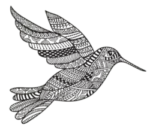(Or: How Nature’s Living Jewels Use Their Rainbow Arsenal)
In the complex world of hummingbird survival, color isn’t just about looking pretty – it’s a sophisticated tool kit that serves everything from dinner invitation to dating profile. These living prisms have mastered the art of using color in ways that would make both artists and military strategists take notes.
Let’s start with some colorful facts that make optical scientists reach for their spectroscopes:
- Ability to see ultraviolet light
- Iridescent feathers that change color with angle
- Color-based flower recognition
- UV patterns invisible to human eyes
- Strategic color displays for reproduction
The Ultimate Color Vision
Imagine having eyes that make high-definition television look primitive. Hummingbird color vision doesn’t just exceed human capabilities – it enters realms we can barely comprehend. These tiny aviators see a world awash in colors we can’t even imagine, including ultraviolet patterns that serve as nectar road maps.
Their visual capabilities include:
- Enhanced UV sensitivity
- Superior color differentiation
- Rapid movement processing
- Pattern recognition excellence
- What amounts to nature’s best color detection system
The Breeding Rainbow
In the world of hummingbird reproduction, color plays a role somewhere between peacock pageant and sophisticated signal system. Male hummingbirds use their iridescent plumage like living billboards, advertising their fitness with flashes of brilliant color.
Breeding color strategies include:
- Strategic iridescent displays
- Angle-dependent color changes
- UV signalling patterns
- Territorial color markers
- Synchronized color flashing
The Feeding Palette
Finding food in a complex environment requires sophisticated color recognition abilities. Hummingbirds have developed an extraordinary capacity to remember and recognize color patterns associated with high-quality nectar sources.
Feeding color adaptations include:
- Precise flower color memory
- Pattern recognition
- UV nectar guides detection
- Color-based resource mapping
- Temporal color tracking
The Camouflage Game
Not all color use is about standing out. Sometimes survival depends on disappearing into the background, especially for females and nesting birds.
Camouflage strategies include:
- Environment-matched plumage
- Situational color use
- Nest concealment patterns
- Predator avoidance coloring
- Strategic color dimming
The Physics Behind the Flash
The production of hummingbird colors involves some of nature’s most sophisticated optical engineering. These aren’t just pigments – they’re structural colors created by microscopic features that manipulate light itself.
Color production methods include:
- Nanoscale feather structures
- Light-interference patterns
- Melanin arrangements
- Protein structures
- What amounts to living optical technology
The Communication Spectrum
Colors serve as a sophisticated language in hummingbird society, conveying messages about everything from territorial boundaries to mating availability.
Color communication includes:
- Status signalling
- Territory marking
- Mate attraction
- Aggression displays
- Social hierarchy indicators
The Survival Spectrum
Color plays a crucial role in daily survival, helping hummingbirds navigate their environment and avoid dangers while maximizing resources.
Survival applications include:
- Predator detection
- Resource location
- Territory defense
- Safe haven identification
- Navigation assistance
The Environmental Match
Hummingbird colors haven’t evolved in isolation – they’re precisely tuned to their specific environments and the visual background against which they operate.
Environmental adaptations include:
- Habitat-specific coloration
- Season-appropriate patterns
- Light condition adaptation
- Background matching
- Contrast optimization
The Energy Investment
Producing and maintaining brilliant coloration requires significant energy investment. Hummingbirds must balance the costs and benefits of their color displays.
Energy considerations include:
- Feather maintenance
- Display energy costs
- Nutrient requirements
- Molt timing
- Resource allocation
The Future of Color
As environments change, the role of color in hummingbird survival continues to evolve, presenting new challenges and opportunities.
Future considerations include:
- Changing light conditions
- Habitat alterations
- Evolutionary pressures
- Human impact adaptation
- Climate change effects
Conclusion: Living Color Masters
The role of color in hummingbird survival and reproduction represents one of nature’s most sophisticated uses of the electromagnetic spectrum. These tiny birds have mastered the art of using light in ways we’re still trying to understand.
Remember: When you see a hummingbird’s colors flash in the sunlight, you’re witnessing not just a beautiful display, but a sophisticated survival strategy refined over millions of years of evolution.
Post Script: Some researchers suspect hummingbirds can see colors that don’t even exist in our visual spectrum. The birds aren’t commenting on this theory, but their precisely targeted feeding patterns suggest they might know something about color that we’re still trying to figure out.


